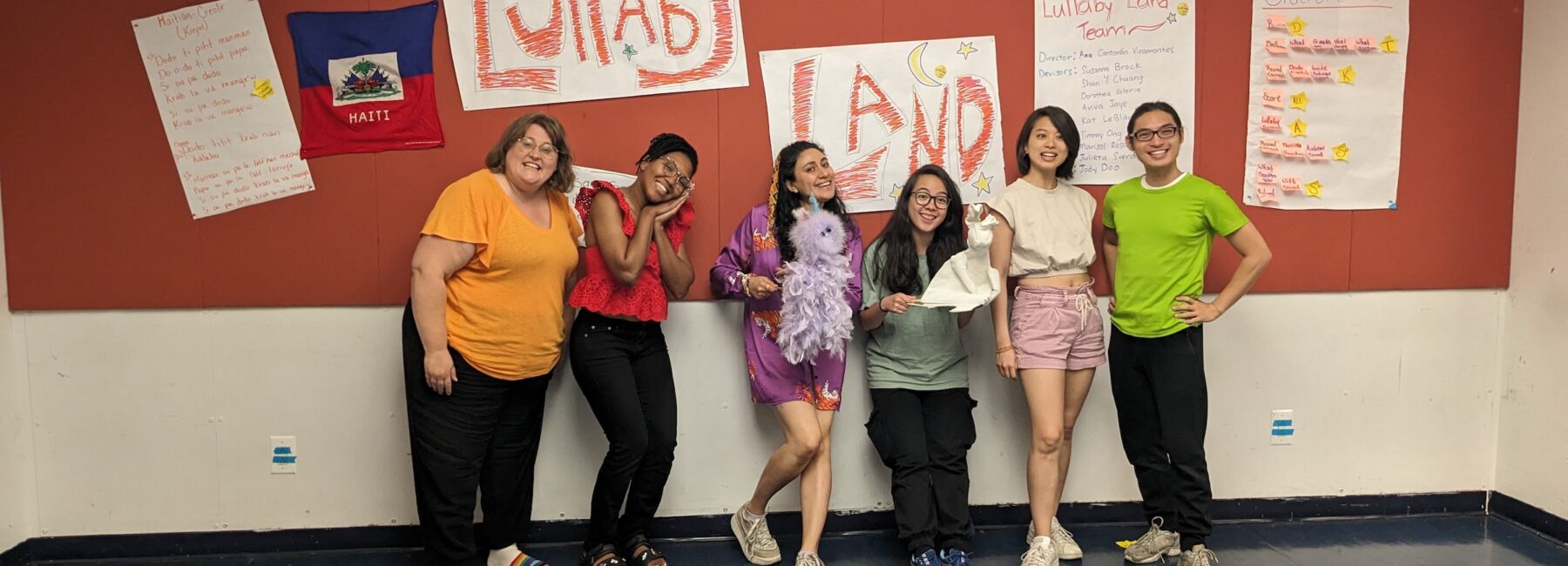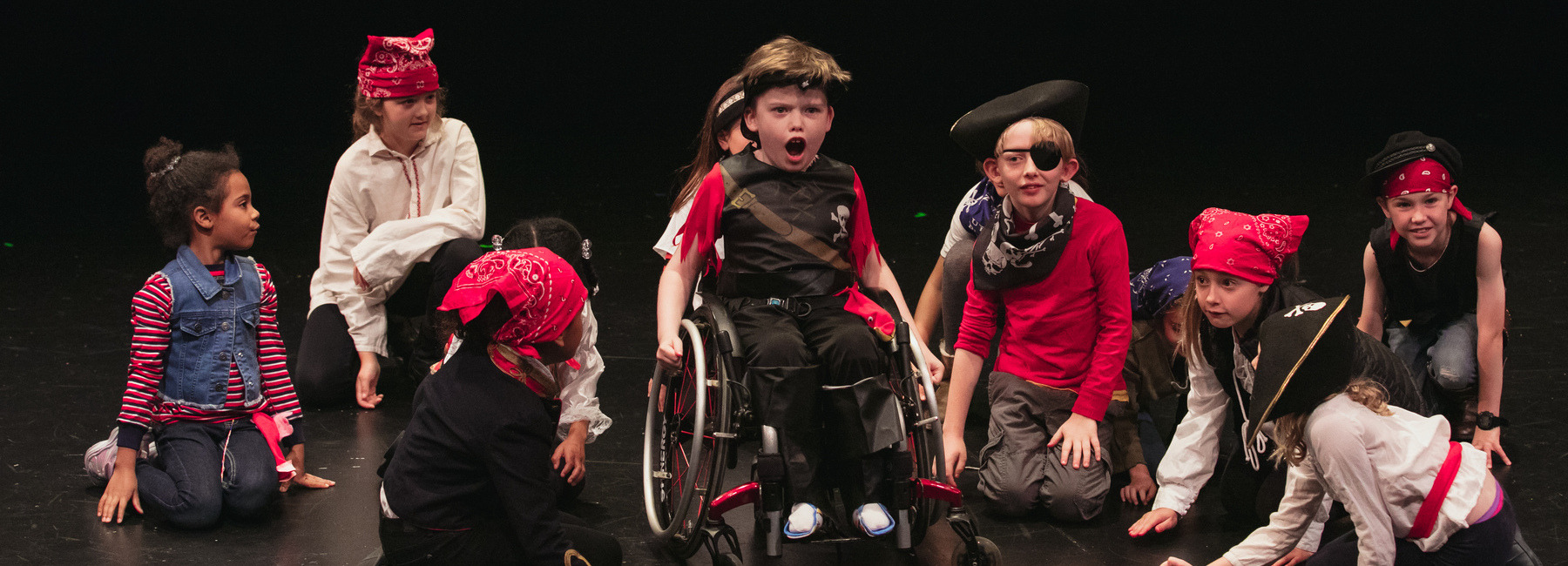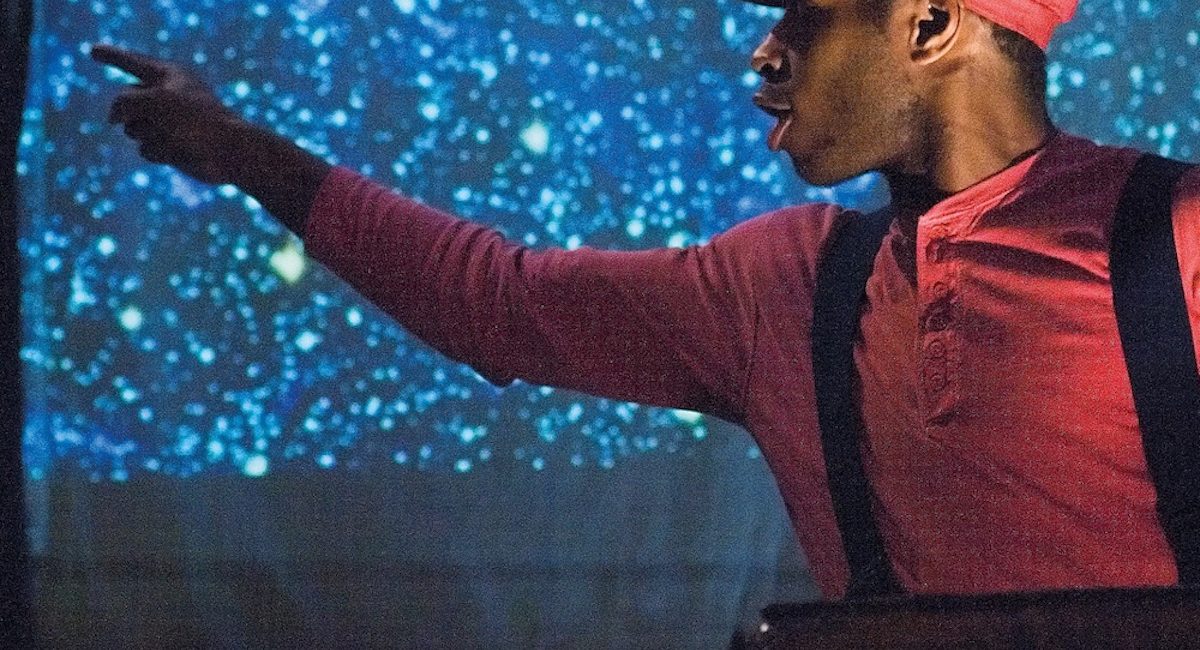As I arrived at the third floor of the Alliance Theatre, I could hear the enthusiastic voices of preschool students. I entered a room lit only by white holiday lights, filled with preschool students and their teachers busy exploring the themes of the play, Do You Love the Dark? Some students were coloring, while others were playing with flashlights and shadow puppets on a screen. As open playtime ended, an actor, dressed in a robe as the mother of the character Maya, appeared and invited the group to get a stuffy (stuffed animal) and to come into the theatre where they could find their own blanket to sit on for the production. Throughout the 30-minute production, the audience was invited to help the young protagonist deal with her fears of the dark. There was no fourth wall, and both the children and adults were encouraged to participate throughout the performance. It was a magical 30 minutes in the theatre.
Theatre for the Very Young (TVY) plays are designed specifically to entertain and engage the very youngest theatre patrons: children ages 0-5 years old. TVY has long been produced around the globe but is still in its nascent stages of development and production in the US.
I attended four ASSITEJ international conferences and found myself mesmerized by the seemingly simplistic, yet creative TVY. In 2019, I decided to produce a TVY play at my university and was challenged to find a published script that was at the level of creativity and connection to young children as I had seen at numerous national and international TYA festivals. One US theatre is ambitiously developing, creating, and performing ambitious TVY: The Alliance Theatre in Atlanta, GA. The Alliance team has created a model of how to develop thoughtful, imaginative, age appropriate, and inclusive TVY.
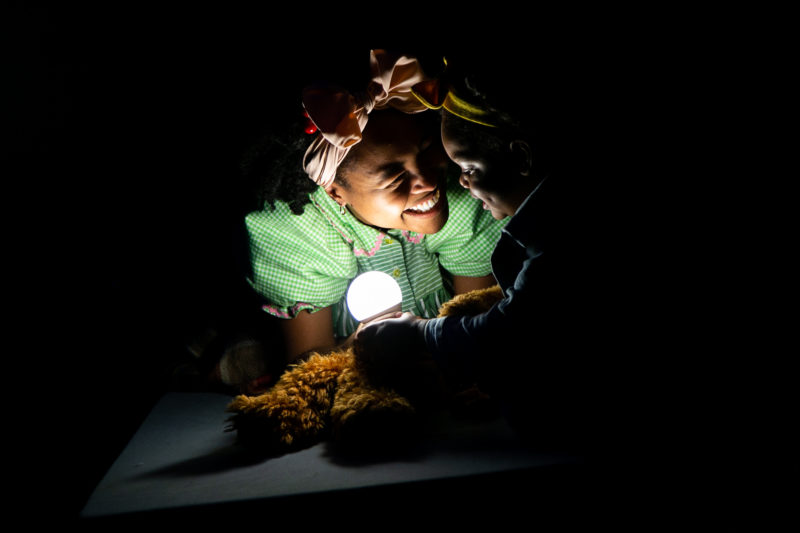
Do You Love the Dark – Actor Jessenia Ingram in the Alliance Theatre’s Kathy & Ken Bernhardt Theatre for the Very Young production DO YOU LOVE THE DARK? Photo by Casey Gardner Ford.
I visited the Alliance during a very busy week of productions, programs, rehearsals, and new play development during the first week of October 2022.
In only 5 days, I saw:
· 1 play for adults (Everybody)
· 1 TVY production (Do You Love the Dark?)
· 1 community event (Babies Off Book)
· 1 TYA play (The Incredible Book Eating Boy)
· 1 rehearsal of a TYA/TVY play (Roob and Noob)
· 1 TVY play in development (All Smiles)
I interviewed Chris Moses, Dan Reardon Director of Education & Associate Artistic Director, Rosemary Newcott, the former Sally G. Tomlinson Artistic Director of Theatre for Youth and Families, Olivia Aston Bosworth, Head of Youth and Family Programs, and Sam Provenzano, Resident Artist and Teen Programs Manager. Currently under the leadership of Aston Bosworth, the Alliance will produce 4 TVY plays this season including one new TVY world premiere. There are an additional 8-10 TVY productions ready to go in storage at the theatre. Most impressive, the Alliance provides free tickets to every child under the age of 5. This community engagement and new play development is supported by a generous donation from the Kathy and Ken Bernhardt endowment.
The endowment funds the development and large reach to the Atlanta community of very young children. In 2019-2020, the Alliance had 10,484 patrons for in-person performances and in the pandemic, their virtual show In My Granny’s Garden reached 5,548 patrons. The 2020-2021 TVY season reached roughly 26,000 streaming audience members and the 2021-2022 season served 4,531 in-person audience members and 4,985 patrons streamed an online performance. The numbers in the 2019-2020 numbers were lower because of reduced audience capacity size for Covid safety, no tours, and age limited to 3–5-year old’s instead of 0-5 year old’s. All Atlanta Public School Pre-K students have access to live theatre throughout the season through school field trips. This year, that number alone will be 1,098 in addition to the other field trips and families in attendance. Two out of our four productions this season have been extended to accommodate demand. To mount a world premiere TVY production, including developmental workshops, it costs a minimum of $40,000 (Aston Bosworth).
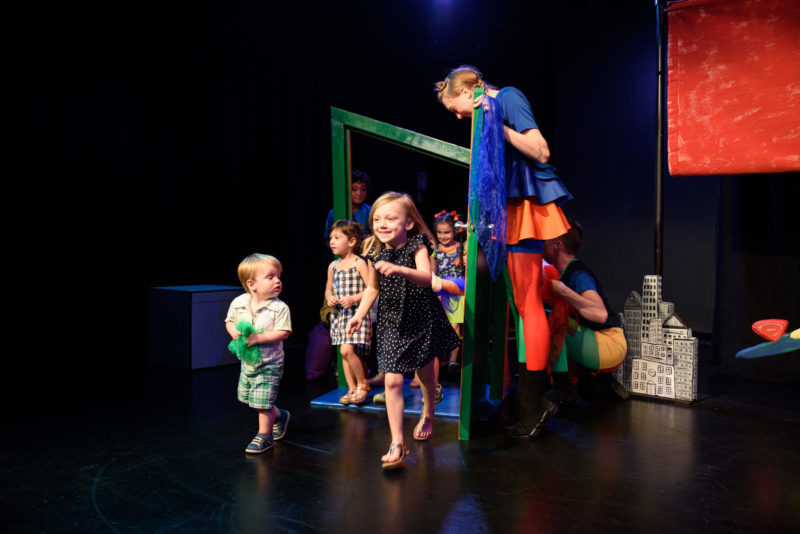
Hey Willy – Actor Melissa Word in the Alliance Theatre’s Kathy & Ken Bernhardt Theatre for the Very Young production HEY WILLY, SEE THE PYRAMIDS. Photo by Greg Mooney.
How did the Alliance come to develop TVY?
In 2002, Newcott attended the ASSITEJ World Congress in South Korea, where she was first exposed to TVY and inspired to do this work at the Alliance. Her education department colleagues supported the idea and worked to find financial support for this new endeavor. Carol Trageser Jones, the Director of the Institute for Educators, collaborated to find funding to develop new TVY pieces and to make these productions affordable or at no cost for young people. Immediately the Alliance intentionally provided these plays to traditionally marginalized youth in the Atlanta region.
Pillars of TVY
After leading the development of many TVY plays, Aston Bosworth named 3 pillars of TVY that are true for each developed piece:
1. Invitation to play: what is the reason the children are entering space? Each production carefully considers how the pre-show experience leads the children into space. Each team considers what their offering of engagement is to the children.
2. Interactivity: The children must be active every 5 minutes throughout the show. Each ensemble considers all five senses in creating these moments of interaction. These moments of interaction can vary for different ages and levels of comfort. A baby on a lap could be engaged visually, while a toddler may run up on stage to grab a prop.
3. The audience is always the expert: If the actors are ahead of the audience, the children are lost and disengaged. The very young audience members are the key to unlocking the steps in the story. If a character has to figure out something or needs something in the story, the very young audience is there as the other characters in the play, who happen to be the experts of that something.
What is the process to develop a new TVY play?
Stage 1: Inspiration
The inspiration for each new TVY work comes organically to the artists and education team and can take 1-2 years to develop into production. Almost all the pieces are newly devised works created by artists from the Alliance or Atlanta community. Some pieces use a book as a springboard, like this year’s Do You Love the Dark? by Maya Lawrence and illustrated by R. Gregory Christie in partnership with the Mayor’s Summer Reading Club. Some production themes arise to meet the needs of different populations. All Smiles will explore non-verbal communication and hopes to specifically reach children ages 0-5, including students on the Autism spectrum. Each piece has very little text and must include the audience as active participants. When possible, a live musician accompanies the live action on stage, however, often a composer is hired to attend play development workshops, write, and record music.
Stage 2: Exploration
Once a theme or story is chosen, the director leads exploratory workshop sessions where initial ideas are explored widely. In the second workshop series, the director comes in with “a container, narrative, and ideas of how to make the piece interactive for the audience” (Provenzano). In the 5-day development workshop I attended, there were 3 actors, a sound engineer, a composer, a Spelman College TYA intern, Aston Bosworth, and her expert curious one year old baby on occasion. The ensemble was led by Sam Provenzano, the director and facilitator of All Smiles. I was there to observe but was immediately invited to participate. What amazed me was the way that Provenzano led the entire week from a sense of true play, whimsy, and collaboration. Everyone in the room was an equal creator in the piece, from a baby watching to a director leading. Everyone.
On the first day of rehearsal, Provenzano entered the rehearsal room and drew a map on the dry erase board of what she saw as the journey of All Smiles. In small groups, all the artists invented ways that a smile could be sent. Later, the group invented ways to invite the young audience to participate in the delivery of a smile.
On day two, the goal was to create something that could be shared and tested with an audience of 3–5-year-olds on day 3. Provenzano bravely started the day by saying, “I’m scared. We have to share something tomorrow, but I don’t think the work we did yesterday met our goals of the piece, so I’m going to give us a new starting place today.” The actors were given the assignment to create 10 ways to deliver a smile. They found inspiration from the storage room and shared their creative ideas with one another. By the end of the day, the team created 15 minutes of interactive material to test out with a young audience.
Everyone in the room was an equal creator in the piece, from a baby watching to a director leading.
Stage 3: Test Audiences
On day 3, the team went to a local ECE-K school with mixed neurodiverse and neurotypical students and performed 3 sharings of the work created on Monday and Tuesday. The actors used 3 clear, large visual foam pieces to demonstrate different types of smiles. This iconography provided a focusing point of curiosity for children to explore the theme. Between each sharing, Provenzano would ask, “what did we learn?” The whole team, from sound engineer to actor, reflected on when the students were unclear or when they were enthusiastically engaged. In my interview with Moses, he explained, “this day is essential. It’s the special sauce to our success.” I was very impressed with the actors’ ability to reflect, change, and immediately turn around and present new ideas within a few moments. The main adjustment for each presentation centered on fine tuning the ways that the audience participated throughout the piece.
On Thursday, the team headed to the High Museum’s weekly event, Toddler Thursday, just across the courtyard from the Alliance. This free event for children under age 5 provides thematic arts-based activities for young children each week. The All Smiles team invited the very young children in the room to participate in the latest draft of All Smiles. Present in the audience were a group of experts from the Marcus Autism Center. These educators gave very thorough feedback on how the piece would connect to students on the Autism spectrum. They particularly enjoyed the amount of non-verbal clear cues offered to the audience.
Thursday afternoon and Friday morning, Provenzano continued to explore different facial variations of a smile through improvisation and movement. Based on specific feedback from the Autism experts on Thursday morning, the ensemble played with the use of mirrors for an interactive activity of facial expressions and body language. This suggestion inspired a new flow of joy, curiosity, and discovery with the entire team.
I appreciated how Provenzano kept the entire 5-day development workshop solidly focused on exploration. In devising, it can be so difficult to stay in the realm of curiosity rather than making final choices for production. The 5-day workshop ended with Provenzano’s reflection question, “what do you want to be true about this piece?” This query encouraged all the artists to share meaningful moments that resonated throughout the week.
Stage 4: Final Product
After a development week, the director takes all the ideas and creates a first draft treatment of the piece together with designers. The ensemble will work collaboratively for a final 3-week rehearsal session. The first week focuses on continued exploration, the second week the ensemble makes final selections to perform, and the third week is dedicated to technical rehearsals. The ensemble performs at 9:30 am and 11:00 am Wednesdays-Sundays at the theatre or on weekdays if the production is touring. All Smiles will tour January 26-March 5, 2023, in the Atlanta area. Provenzano will direct University of Northern Colorado students in an additional tour in Colorado in April 2023.
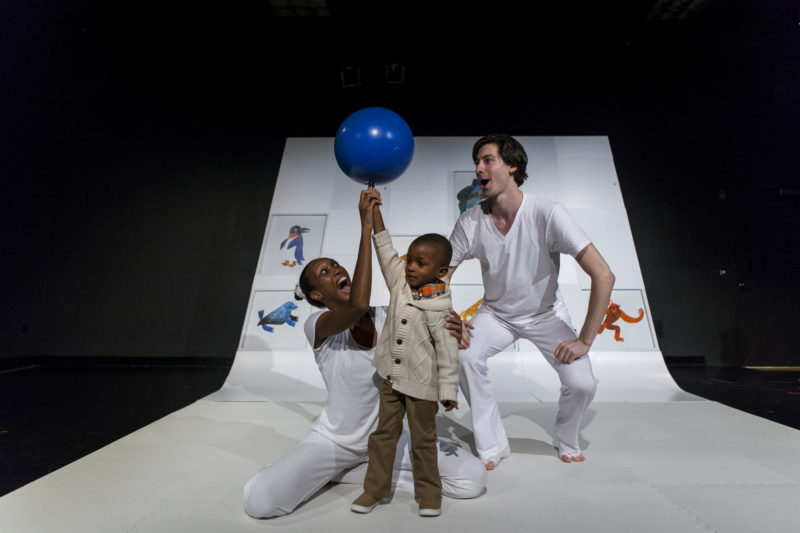
From Head to Toe – Actors Andrea Washington and Matt Baum in the Alliance Theatre’s Kathy & Ken Bernhardt Theatre for the Very Young production FROM HEAD TO TOE. Photo by Alphonso Whitfield.
TVY is an investment in the development of the imagination of the most creative people: very young children.
Why TVY? Why now?
Under the leadership of Chris Moses, attendance at accessible, high quality, engaging theatre is a birthright for all children (preschool to 12th grade) in the city of Atlanta. This is not a lofty goal. The Alliance is achieving this purpose with deliberate focus. The education team hires diverse artists who are dedicated to TVY and intentionally dedicates significant human and financial resources to promote accessible, inventive theatre experiences for the very youngest audiences. I saw first-hand how the Alliance not only reaches large numbers of young audiences, but also collaborates with educators, experts, and artists throughout Atlanta to develop age appropriate, interactive, innovative theatre. The TVY work they create is at the same level of excellence as the TVY pieces featured at international festivals. TVY is not a money-making investment for theatre companies, however, it is an incredibly rewarding and challenging journey. This work is an investment in children, schools, families, and community. Most importantly, TVY is an investment in the development of the imagination of the most creative people: very young children.

